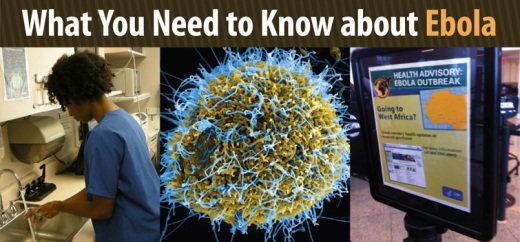CDC Highlights What You Need to Know About the Ebola Virus
/
Ebola, previously known as Ebola hemorrhagic fever, is a severe, often fatal disease in humans and nonhuman primates (such as monkeys, gorillas, and chimpanzees). The 2014 Ebola epidemic is the largest in history. The following information about Ebola is courtesy of the CDC.
Ebola is a rare and deadly disease caused by infection with a virus of the family Filoviridae, genus Ebolavirus. There are five identified Ebolavirus species, four of which have caused disease in humans: Zaire ebolavirus; Sudan ebolavirus; Taï Forest ebolavirus, formerly Côte d’Ivoire ebolavirus; and Bundibugyo ebolavirus. The fifth, Reston ebolavirus, has caused disease in nonhuman primates but not in humans.
Ebola is found in several African countries. The first Ebola species was discovered in 1976 near the Ebola River in what is now the Democratic Republic of the Congo. Since then, outbreaks have appeared sporadically in Africa.
The natural reservoir host of Ebola remains unknown. However, on the basis of available evidence and the nature of similar viruses, researchers believe that the virus is animal-borne, with bats being the most likely reservoir. Four of the five subtypes occur in an animal host native to Africa.
When an infection does occur in humans, there are several ways the virus can be spread to others. These include: direct contact with the blood or body fluids of a person who is sick with Ebola or contact with objects that have been contaminated with the blood or body fluids of an infected person or with infected animals
The virus in the blood and body fluids can enter another person’s body through broken skin or unprotected mucous membranes such as the eyes, nose or mouth.
During outbreaks of Ebola, the disease can spread quickly within healthcare settings, such as clinics or hospitals. Exposure to Ebola can occur in healthcare settings where hospital staff are not wearing appropriate protective clothing including masks, gowns, gloves and eye protection.
A person infected with Ebola is not contagious until symptoms appear. Signs and symptoms of Ebola typically include: Fever (greater than 101.5°F), severe headache, muscle pain, vomiting, diarrhea, stomach pain, unexplained bleeding or bruising.
Symptoms may appear anywhere from 2 to 21 days after exposure to Ebola but the average is 8 to 10 days.
Recovery from Ebola depends on the patient’s immune response. People who recover from Ebola infection develop antibodies that last for at least 10 years.
Diagnosing Ebola in a person who has been infected for only a few days is difficult because the early symptoms, such as fever, are not specific to Ebola infection and are seen often in patients with more commonly occurring diseases, such as malaria and typhoid fever.
However, if a person has symptoms of Ebola and had contact with blood or body fluids of a person sick with Ebola, contact with objects that have been contaminated with blood or body fluids of a person sick with Ebola or contact with infected animals, the patient should be isolated and public health professionals notified. Samples from the patient can then be collected and tested to confirm infection.
Currently there are no specific vaccines or medicines (such as antiviral drug) that have been proven to be effective against Ebola.
Symptoms of Ebola are treated as they appear. The following basic interventions, when used early, can significantly improve the chances of survival: providing intravenous (IV) fluids and balancing electrolytes (body salts), maintaining oxygen status and blood pressure, treating other infections if they occur
Timely treatment of Ebola is important but challenging since the disease is difficult to diagnose clinically in the early stages of infection. Because early symptoms such as headache and fever are not specific to Ebolaviruses, cases of Ebola may be initially misdiagnosed.
As of October 31, 2014, there have been 4 reported cases of Ebola in the U.S.:
- 9/30/14: Man who traveled to Dallas, TX from Liberia; he passed away on 10/8/14
- 10/10/14: Healthcare worker who cared for initial patient; recovered and discharged 10/24/14
- 10/15/14: 2nd healthcare worker who cared for initial patient; recovered and discharged 10/28/14
- 10/23/14: Medical aid worker who returned to New York from Guinea diagnosted and confirmed next day. In isolation as of 10/31/14.
More information on Ebola cases reported in the U.S. at www.cdc.gov/vhf/ebola/outbreaks/2014-west-africa/united-states-imported-case.html.
Learn more about Ebola at www.cdc.gov/ebola.


